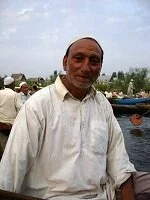Dress

Floating Market
The dress in India today is a combination of western-styled and traditional clothing and after a few days in the country the mix may become second nature. Among the traditional clothing items for women are the sari, ghagra choli, salwar kameez, and others, many of which resemble western-styled clothing more than they do the sari. The sari is a long piece of cloth that is elegantly wrapped to cover one's self entirely, although sometimes a shoulder is seen. The ghagra choli appears to be a combination of a sari with a western-styled dress, and the salwar kameez refers to a shalwar, or loose-fitting pants and a kameez, which is a long shirt or tunic. For men the traditional wardrobe consists of a dhoti, lungi (or sarong), and others. The dhoti a long piece of cloth wrapped around the waist to act as pants, while the lungi is a sarong, which is always white.
Although the above mentioned pieces of clothing are perhaps the most common in India, the country and people are incredibly diverse and their dress is as well. Many Muslims wear more traditional Islamic dress that is similar to that found elsewhere in the Islamic world, while women tend to cover their hair. The Sikhs don't cut their hair so wrap their hair in a turban called a dastar and often wear a metal bracelet, as indicated by their religion. There are literally hundreds of traditional outfits in India, most of which are based on religion and ethnicity, but which also vary based on geography.
Despite all the differences, modern western-styled clothing is becoming more and more popular in India today, especially in the cities. Although this style is western, the clothes is still very conservative as few people will show much skin; most clothing completely covers the arms and legs, although some outfits do show shoulder or the lower arms or legs on women. For men it is rare to see someone wearing anything that doesn't completely reach to their ankles and wrists (other than along some beaches, like Goa). As a visitor to India try to dress in like fashion, with arms and legs covered at all times, especially if traveling to heavily Islamic parts of the country. If in doubt, dress on the more conservative and formal side when in India and always cover up.